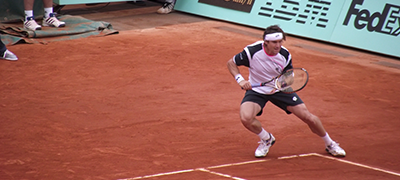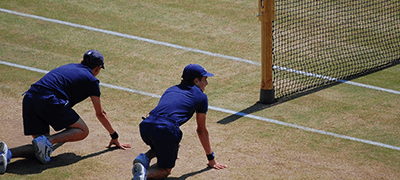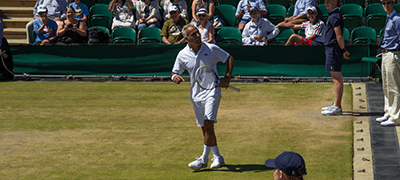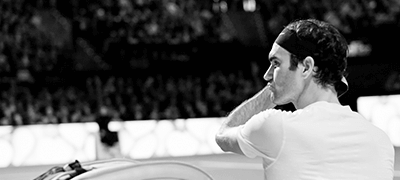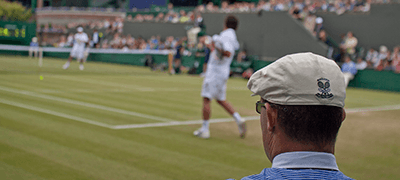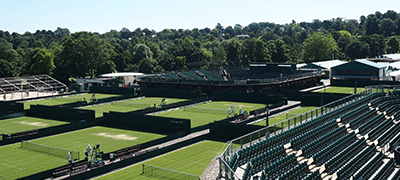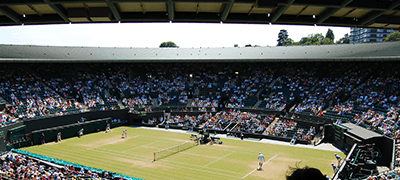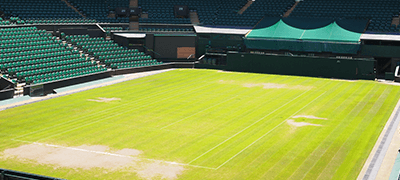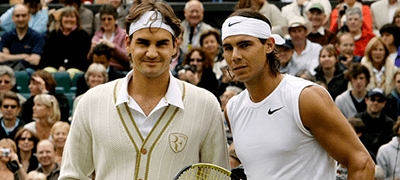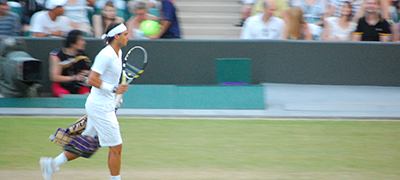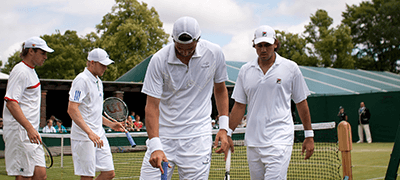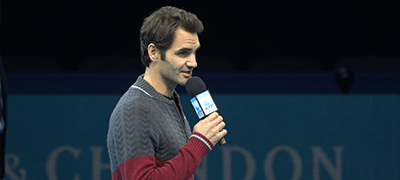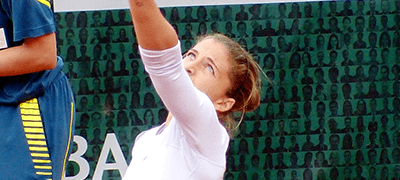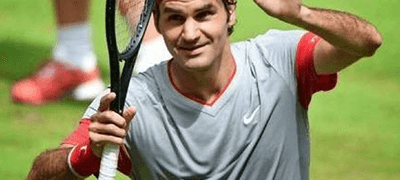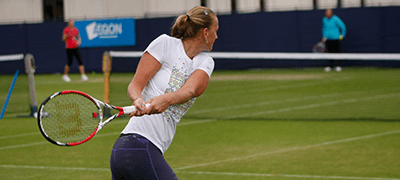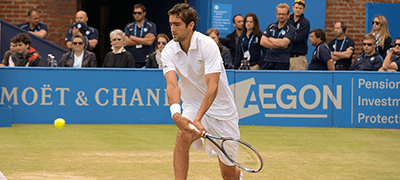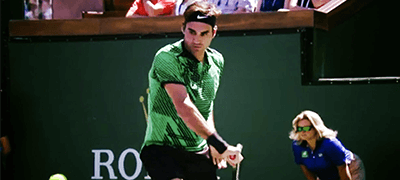Ranking Rafael Nadal's European clay court seasons (2005-2018)
Jul 14 29 min read
1:44 pm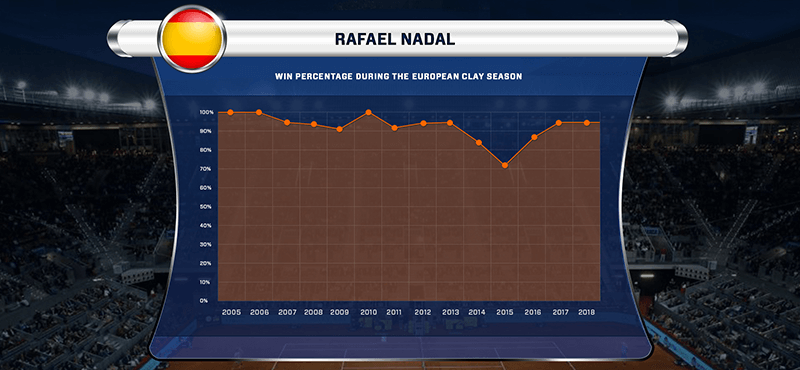
The European clay court season used to be a time of unpredictability in tennis. Several all-time greats, from McEnroe to Sampras, fared rather poorly in this stretch of the tour. This allowed for a little diversity to be sprinkled into the top of the men’s game. Unexpected tournament runs like Guga in 1997, memorable milestone moments like Agassi in 1999, and dramatic season climaxes like the 2004 Roland Garros final all characterised the mutable nature of the sport on clay, much like the mutable clay itself.
Beginning in 2005, however, all that changed. The arrival of Rafael Nadal marked the inversion of clay’s traditional role on the world tour, from the great equaliser to the great divider. Post-2005, there was Nadal, and then everyone else. In the 14 years since, Nadal has established the greatest stranglehold in modern sport. His dominance is simply flabbergasting: 36 losses to over 400 wins, 57 titles, multiple Slams won without dropping a set. His own standards are so impeccably high that it is a talking point when he loses a set on clay, let alone a match.
Surprisingly enough, his game hasn’t always been consistently brilliant on clay. In some years, Nadal has gotten by simply on the virtue of being the best clay court player in history, a step above the rest even when he is mediocre. And in even worse years, he has actively struggled to assert his supremacy over the rest of the tour. On the other end, he has had years where he has looked absolutely untouchable. As has been said by many in the past - peak Rafa Nadal on clay is the man you would choose to save the world if aliens held it hostage over a sporting event. Let us rank the 14 clay court seasons Nadal has played since he turned 18. This only includes his performances in the European season from April to June; that is, Monte-Carlo, Barcelona, Madrid/Hamburg, Rome and Roland Garros.
14. 2015
- W/L: 14-5
- Titles: 0
- Sets lost: 14
Perhaps the easiest year to place is 2015 - Nadal’s worst clay season by a significant margin. His woes had begun the previous year when, for the first time in his career, he went into Roland Garros with just two clay court titles to his name. 2015 would prove even worse. At Monte Carlo, he sneaked past Isner and Ferrer in tight three-setters before crumbling to his nemesis Djokovic in the semi-finals. At Barcelona, he imploded in a strange match against Fognini. His forehand was dropping unbelievably short, a killshot turned into a massive liability.
A spot of momentum seemed to come his way at Madrid, where he made it to the final without dropping a set. There he faced Murray, who had made his first ever clay court final just one week prior. Surprisingly, yet rather unsurprisingly, Murray crushed him 6-3, 6-2. Nadal is a confidence player, and thus the string of poor results continued to pile up. At Rome, Wawrinka blasted him off court. He went to Paris with his tail between his legs, awaiting an inevitable loss on Chatrier.
After a few decent rounds, he limped into the quarter-finals, where he met Djokovic. It seemed seventh time was the charm for Djokovic, who was 0-6 against the Spaniard in Paris. He wiped the floor with Nadal in three quick sets, handing him his second ever loss in a best-of-five match on clay. Nadal’s results were downright terrible by his own standards, and were reflected in his sorry win-loss record for the season.
13. 2014
- W/L: 20-3
- Titles: 2
- Sets lost: 12
It seems strange that Nadal’s second worst clay season is one in which he won Roland Garros. However, at the time, 2014 truly seemed to be a turning point in his career. Every year since 2005, he had made it to the finals of at least two of the three Masters events on the dirt, and excluding 2011, he had won at least two each year too. Going into 2014, it seemed like nothing would change. The first bomb dropped in Monte Carlo, where he lost before the finals for the first time in 10 years. Ferrer, whose last win over him on clay was in 2004, beat him in straight sets in the quarter-finals. The bombs kept falling. The following week, he suffered his first loss in Barcelona in a decade, losing to Almagro in the quarter-finals. It was the first time he had failed to win either Monte Carlo or Barcelona since he was 17. A decade-long vice-grip on the surface seemed to be coming to an ugly end.
However, he found some momentum in Madrid, reaching the final without dropping a set. The Nadal-Nishikori final was rather absurd, to put it mildly. Nishikori came out all guns blazing and took the first set 6-2. It seemed like yet another bastion of the Nadal empire was about to fall. A momentum shift and an injury later, the match was done. Nadal won 2-6 6-4 3-0, with Nishikori retiring during the third set. Fate had been kind to Rafa that day, the victory no doubt bittersweet. He carried this mediocre form into Rome, where he dropped sets in his first three matches. A hard-fought battle with Djokovic in the final ended with a three-set victory for the Serb.
And so Nadal went into Roland Garros with close to no confidence after his worst clay court season ever. What would happen? They say champions are forged in difficult times, and that was what ensued. Nadal played a dominant tournament in Paris, dropping just two sets and 57 games en route to his ninth Roland Garros title. Paris remained his, despite a below average season.

12. 2016
- W/L: 17-2
- Titles: 2
- Sets lost: 8
After two miserable clay court seasons in succession, few had faith in Nadal’s ability to return to the top. He is, however, the king of clay for a reason. He came into Monte Carlo with absolutely no momentum after a bad, bad year. Djokovic smashed him to start the season, then Verdasco dumped him out in the first round of the Australian Open. After that, he lost in the semis of two clay court events in South America. Djokovic beat him again at Indian Wells and then he retired during his first match in Miami.
Nadal has traditionally refuelled on clay after disastrous results on other surfaces, and this was exactly what he managed to do. A strong tournament in the principality saw him lift his ninth Monte-Carlo trophy, with hard-fought wins over Murray and Monfils boosting his confidence. He carried this form into Barcelona, where he romped to a ninth title, dropping no sets on the way. It didn’t last forever, sadly, and he began to show signs of slowing down. Murray beat him in the semis of Madrid, and then Djokovic beat him in a classic quarter-final in Rome. What would Roland Garros bring? Misery and depression, it would turn out. After a strong first two rounds, he pulled out of the tournament with a wrist injury, crying on his way home. It was a low point in his career, and seemed to be the final nail in his coffin.
Objectively speaking, 2014 was a better year for him - he did win Roland Garros that year. However, context is crucial. In 2014, he came into the clay court season with oodles of positive energy. A masterful 2013 hard court season and a run to the finals of the Australian Open soon after brought him to the clay as the undisputed best player on the planet. When he left, that fact seemed far less certain. Clay is his home - it is where he rejuvenates and nourishes himself and heals the agonies of past defeats. In 2014, that did not happen. In 2016, it did. His victories at Monte-Carlo and Barcelona were tokens of vengeance for the horrors of the previous year, and turned out to be stepping stones to the renaissance of his legendary career.
11. 2009
- W/L: 20-2
- Titles: 3
- Sets lost: 7
What a year 2009 would be for Nadal. It began with him atop the peaks of tennis, having wrested the throne from Federer after a magical 2008 season. It seemed like it would go on forever, with titles at the Australian Open and Indian Wells taking him into the clay court season playing the best tennis of his life. Nothing would stop this train.
First, his fifth straight Monte Carlo title, with just one set lost. Next, his fifth straight Barcelona title, no sets lost. Then, a fourth title in the Eternal City, including a vicious 6-1 6-0 beatdown of Soderling in round two. He went into Madrid as the undisputed king of tennis. There, in the semi-finals, he met Djokovic, who he had beaten twice already that clay season, in the finals of Monte-Carlo and Rome. They would play possibly the greatest ever three-set match in tennis history, clocking in at a ridiculous four hours and three minutes. The match seemed to go on forever - both men at their physical peaks, rallying endlessly, fighting tooth and nail for every single point. Djokovic was playing some of the best tennis he had ever played, earning two match points for his efforts. Nadal crushed them both and won the match in a gripping third-set tie-breaker. The match seemed to drain the life out of both players, and would prove to be a major inflection point in the story of the season. The final was held the next day, and to nobody’s surprise, a tired Nadal lost rather meekly to Federer. You couldn’t quite fault him for that loss, after all, he was absolutely exhausted.
Little did we know that it was about to get worse. Roland Garros came around, with Nadal a massive favourite for the title, having never lost there. He dispatched his first three opponents with ease, and was matched up with Soderling in the fourth round. Given the drubbing he had given the Swede just a few weeks earlier in Rome, it seemed like a no-brainer that he would win. What happened was a no-brainer indeed - no one with a brain could have called it. The biggest upset in tennis history - a four-set win for Soderling, Nadal’s first ever loss in a best-of-five match on clay.
His incredible 12-month run had come to an earth-shattering halt. The king was dead. Until that match with Djokovic, he had dropped just one set in sixteen matches. After that match, he lost six sets in five matches. What could have been an all-time great finish to the season was ended abruptly by a defeat no one saw coming.
10. 2011
- W/L: 24-2
- Titles: 3
- Sets lost: 10
Reaching all five clay finals and still having it be only your 10th best clay season - these are #justNadalthings. The reason 2011 comes in so low is because it is arguably the only year in which a peak Nadal has lost finals on clay. His record in clay finals stands at 57-8. Four of those losses are to Djokovic, two of them in 2011. After retiring mid-way through their 2006 Roland Garros match, Djokovic famously declared to him - “you are not unbeatable on clay, you are beatable”. It would take five years before he would fulfil his prediction, and by god he fulfilled it in style. Novak 2.0 entered 2011 with a chip on his shoulder, bulldozing his way through the first half of the season, winning titles at the Australian Open, Indian Wells and Miami, with two wins over Nadal in finals.
The clay season thus began with an age-old clash looming on the horizon - the unstoppable force versus the immovable object. What would come of it? Djokovic skipped Monte Carlo, so we would have to wait a while longer to see. Nadal made hay while Djokovic was away, racking up his seventh straight Monte Carlo title and a sixth Barcelona title. Djokovic returned at Madrid, and faced Nadal in the final. In an entertaining contest featuring splendid rallies and even a tweener lob, Djokovic bested Nadal in straight sets. The rampage continued in Rome the following week, with Djokovic coming out on top in yet another final.
For the first time in his career, Nadal had lost twice in the lead-up to Roland Garros. Was he shaken? It seemed so. In the first round against Isner, Nadal was pushed to five sets for the first time ever in Paris. He recovered remarkably well, however, and stormed to the final without losing another set. There he awaited the winner of the other semi-final. Either Federer or Djokovic, who was 43-0 at this point in the season, with two victories over him on clay. It seemed only an act of god could stop Djokovic from taking Nadal’s kingdom at this point. And an act of god himself was indeed what transpired. In a quintessential performance, the red-clad Fed hit Djokovic off the court with sublime touch, setting up a fourth Federer-Nadal Roland Garros final. This one would turn out to be the closest, but it just wasn’t close enough for Federer. Nadal pulled off a great escape to maintain his place as the best clay courter on the planet.
Despite reaching all five finals in 2011, his armour was finally beginning to show chinks, and the world was finally beginning to realise that Djokovic’s bitter statement from all those years ago was a prophecy and not just another unfounded opinion.

9. 2013
- W/L: 26-1
- Titles: 4
- Sets lost: 10
It must be said again - it is absurd that a season with four titles and win-loss record of 26-1 is only Nadal’s ninth best clay season. And yet somehow it’s true. While 2013 was nowhere close to a bad year for him on clay, there are just so many other years that were better. As mentioned earlier, clay is where he seeks to gather momentum and confidence for the rest of the season, and there is absolutely no better example of this than 2013. After a shock loss to Rosol at Wimbledon the previous year, he took seven months off with a knee injury. In his first tournament back in February 2013, he lost a clay court final to Horacio Zeballos. It sounds strange, because it is. The only men to have beaten Nadal in clay court finals are the three other members of the Big Four, and Zeballos.
A few tournament wins seemed to establish that he was indeed back, and so he came into the clay season on a 14-match win streak with big expectations. He made the final of Monte Carlo for a ninth consecutive year, but couldn’t make it a ninth consecutive title. Djokovic beat him in the muggy, cloudy conditions he despises, becoming the only man to beat him at each of the three clay Masters events. Putting this blip aside, he went back to work, grabbing Barcelona for an eighth time. On to Madrid, where he brushed aside the competition, dropping one set and taking home the title. Then he staved off an early scare from Gulbis to reach the final in Rome, where he faced old friend and rival Federer. It was a one-sided affair, with Nadal controlling the court with ease and dispatching any challenges Federer threw at him.
Seeded outside the top two at Roland Garros, he drew the short straw, having to potentially face Djokovic in the semi-finals. But first they’d both need to get there. His road was unusually rocky, dropping sets to Klizan and Brands in the first two rounds before picking up some pace and getting to the semis with dominant wins over Fognini, Nishikori and Wawrinka. Djokovic-Nadal was set to happen, and once again, we had no idea who would win. The match turned out to be a thrilling contest with loads of drama to supplement the extraordinary physicality the athletes displayed. Up a break in the fifth but unable to convert, Djokovic would go home empty-handed yet again. A bungled smash helped Nadal edge out the decider 9-7. Nadal eased past Ferrer in the final to claim an eighth Roland Garros trophy.
While this season is one of his best in terms of the competition he faced and beat, he dropped several sets and had a few close contests that could’ve gone the other way. The 2013 clay season would prove pivotal in propelling him to a hard court sweep culminating in his second US Open trophy later that year. It can be argued that this year should be higher up on this list - it was certainly a lot more double-edged and exciting than the ruthless albeit boring domination of other years. However, it is hard to argue with the brute force of the numbers that make up the rest of this list.
8. 2018
- W/L: 24-1
- Titles: 4
- Sets lost: 5
2018 was an odd time for Nadal. He looked both dominant and vulnerable multiple times in the season. Coming off a grand 2017 in which he returned to his former glory alongside best buddy Roger, it seemed like the world was his oyster and the Slams were his for the taking. A hip injury early in the year took him out of the hard court swing, leaving him to return on clay. No better place to return, as he would prove. A pair of Davis Cup victories gave him a running start to Monte Carlo, where he decimated the opposition with a viciousness characteristic of his younger self. He lost just 21 games in five matches, beating top players such as Thiem, Nishikori and Dimitrov, going home with his 11th trophy from Monaco.
This domination had been stewing a while - he hadn’t lost a set on clay since losing to Thiem at Rome the previous year. Since then, he had broken the record for consecutive sets won on clay, held by Coria, and was looking to break McEnroe’s all-surface record (49 straight sets on carpet). The streak nearly died against Klizan in Barcelona, when he faced a few set points. In vintage Nadal style, he saved them and kept going, winning an 11th Barcelona title with ease. In Madrid, he looked sluggish against Schwartzman, but hopped over the line to reach 50 consecutive sets won on the red stuff - a new world record for any surface. He promptly lost to Thiem in his next match, who in turn promptly lost to Zverev in the final. Next, in Rome, he bullrushed the opposition, dropping a set to Fognini before the final, where he faced Zverev. In a bizarre encounter, they traded breadsticks before a rain delay gave him an edge and let him pull ahead in the final set, winning in three for an eighth title in Rome - his first since 2013.
Once again, it seemed like no one could stop him at Roland Garros, and no one really could. The standard he had set was so high that straight sets victories with a 6-4 or a 7-5 set were seen as close, tough matches. After surviving a scare against Schwartzman in the quarters, Nadal played his best matches of the tournament in the semis and final, easily swatting aside del Potro and Thiem with no trouble. He lost one set for the entire tournament. In 2018, he occasionally looked in imperious form and he occasionally looked like his 2015 self, which is why it is in the bottom half of this list.
7. 2005
- W/L: 24-0*
- Titles: 4
- Sets lost: 9
*this doesn’t include Valencia, which was held before Monte Carlo
The teenage phenom from Mallorca truly arrived on tour in 2005, stamping his authority on the clay season in particular. His talent and skill was apparent to all those who watched him, but few could predict the legacy he would carve for himself on the dirt. As Federer once said, “I thought he was probably going to win the French Open once, I didn’t think it was gonna be 10 times…”
His breakout year featured 11 titles, including his first four Masters titles, beginning fittingly in Monte-Carlo. The 18-year old Spaniard destroyed reigning French Open champion Gaudio 6-3 6-0 in the quarter-finals, before slicing through the world’s then best clay courter, Coria, in four sets in the final. He then won his first Barcelona title, dropping zero sets on the way. Next came Rome, where he battled through tough three-setters in the quarters and semis to set up a finals date against Coria.
The ensuing match would change the course of tennis history, in many a way. There are several notable “passing of the torch” moments in sports - Hughes vs. St. Pierre at UFC 65, India vs. Australia at the 2011 Cricket World Cup, Gatlin vs. Bolt at the 2008 Olympic Games, Federer vs. Nadal himself at Wimbledon 2008. This epic clash would earn its place on that list as the Argentinian old guard handed over the reins of the clay horse to the sensational young Spaniard. A gladiatorial five-set thriller in front of a raucous Italian crowd, it featured, without a doubt, some of the most breathtaking baseline tennis to have ever been played. Nadal triumphed that night, winning millions of fans watching across the world, and establishing a new era in men’s tennis - the era of the King of Clay.
Having spent a lifetime’s worth of energy in the Foro Italico, Nadal pulled out of Hamburg, which was due to begin the very next day. He headed straight to Paris for his first ever French Open Championship. He outran and outgrinded a few notable names - Ferrer, Gasquet, Grosjean - on his way to the semis, where he faced the world no. 1, Federer. It was their first ever meeting on clay, and it would set the tone for the rest of their rivalry. Nadal rapaciously targeted Federer’s one-handed backhand with his mile-high topspin, rendering it worse than useless. He was through to his first Slam final after four sets, and he rose to the occasion, dispatching fellow leftie Puerta to win his first Grand Slam. A masterful end to a masterful season, heralding the coming of one of the greatest to ever play the game.

6. 2006
- W/L: 24-0
- Titles: 4
- Sets lost: 9
The coincidences between this year and the previous one are notable. The stats are identical across the board - win/loss record, titles won and sets lost. Unlike 2005, however, Nadal had a very different start to the season. A foot injury derailed the end of his 2005 season and caused him to miss the start of the 2006 season. Coming in to the clay, he was looking to channel its energies for another successful year at the top.
Monte-Carlo was his first stop, and he faced the Argentinian duo of Coria and Gaudio yet again. His game had surpassed Coria’s in every aspect, and a 6-2 6-1 thrashing was in order. One of only three men to have more than two wins against Nadal on clay, Gaudio proved a tougher nut to crack. Dropping a set to him, Nadal moved on to the final, for another match against Federer, who had just begun the best year of his career. As would be the case nearly every time they met on clay, even Federer’s best wasn’t good enough against the lethal cross-court sniper that Rafa called a forehand.
Two in two years, next up was Barcelona. He made it two in two again, could he repeat it in Rome? After a tough first round against mentor Moya, he darted into the final, where Federer awaited. Believe it or not, history repeated itself right away. Another classic five-setter played out, stunningly high in quality, just as good as the previous year’s. Federer played the best clay court match of his life, his grace and artistry painting all corners of the court in front of an enchanted crowd. Nadal scrapped and clawed and produced his own genius, saving match points to win a fifth set tie-break in Rome for the second straight year.
Both Nadal and Federer skipped Hamburg due to the immense drain the battle had placed on their bodies. So far, 2006 looked exactly like 2005 for Nadal, and he looked to keep it that way in Paris. A tough encounter with Mathieu aside, he swept his way to the final. Federer stood in his way for a third time that clay court season, and looked stronger than ever, handing him a breadstick in the first set. To quote Robbie Koenig, Nadal responded with “mine’s bigger than yours”, producing a breadstick and then two more sets to win a second title in Paris. There’s very little to separate 2005 and 2006, as you may have noticed, but the higher quality of opposition means 2006 was a more fruitful year for the young Nadal.
5. 2007
- W/L: 26-1
- Titles: 4
- Sets lost: 5
They say all good things come in threes. Nadal must have believed so, for he came in to the 2007 clay season full of strength. With his inevitable off-clay success growing in spurts, he looked to fortify his home ground. First - Monte-Carlo. Ten straight sets, ending with a quick send-off to Federer in the final. Then - Barcelona. Ten more straight sets. The King of Clay was slowly transforming into the Emperor of Clay. He had finally hit his stride, and developed the skills to become the dominant machine he is now known to be.
In Rome, he dropped just one set and made it three for three at three tournaments in a row. Energised, he played Hamburg for the first time since 2003, making his way to the semis relatively easily. There, he dropped a set in a marathon match against Hewitt, before edging out a close third set 7-5. Foreshadowing what would happen in 2009, a tired Nadal lost to Federer in a strange final, winning the first set 6-2 before losing the second set 2-6 and getting bageled in the third set, ending his 81-match win streak on clay. This bagel meant Federer would eventually be the only man to bagel Nadal on all three surfaces. Additionally, this was the first time Federer had managed to beat him on clay, and so the harkening of doom was writ by pundits across the globe: this would finally be the year Federer would beat Nadal in Paris. In hindsight, these predictions seem funny and ridiculous, but at the time, they seemed a real possibility.
At Roland Garros, Nadal was handed a monster draw. In the first round, he handled a teenage Del Potro with care in straight sets. In the fourth round, former world no. 1 Hewitt, also gone in straights. In the quarters, former French Open champion Moya, three more easy sets, with a bagel for good measure. Djokovic in the semis, back after his famous statement the previous year. Turns out Nadal was still kind of unbeatable in Paris, and Djokovic would have to bide his time a while longer. This death draw, consisting of five former or future Slam champions, culminated with Federer. It went almost exactly like their 2005 semi-final, and Nadal was champion in Paris yet again. This was an exceptional year for Nadal, with only five sets lost through the season. Little did we know that the best was yet to come.
4. 2017
- W/L: 24-1
- Titles: 4
- Sets lost: 4
2017 will be looked back upon as one of the greatest years in men’s tennis history. The revival of the legendary duo of Federer and Nadal titillated fans everywhere, first with the epic Australian Open final, and then Federer’s domination of the Sunshine Double. Clay, however, had historically been Nadal territory, and so Federer gave it a pass. Nadal came in looking to build on his promising results from 2016, and achieve La Decima at three events - Monte-Carlo, Barcelona and Roland Garros.
He got off to a rough start, dropping a set to Edmund in Monte-Carlo. It was all business from then on, as he bashed his way through the draw to pick up a 10th Monte Carlo trophy, - a men’s tennis record for any tournament. He repeated the feat with ease in Barcelona, defeating Thiem to win a 10th title on Barcelona’s centre court, now named Pista Rafa Nadal. In the Madrid semis, Nadal exacted some revenge on Djokovic for his endless recent torment, before battling past Thiem to win a fifth title in his country’s capital. The matches with the young pretender to his throne kept getting closer, and Thiem finally broke through in Rome, playing mind-blowing tennis to hit Nadal off the court in straight sets in the quarter-finals.
A revamped and rejuvenated Nadal entered Paris looking for his first title there in three long years. He clearly felt how long it had been, annihilating every single man who dared face him on Chatrier, dropping just 35 games to win his 10th title in Paris. Bagels and breadsticks abound, he showed no mercy even at the end of the tournament, giving Thiem seven games in the semis and Wawrinka six games in the final. A grandiose performance to cement his legacy as the greatest player on a single surface, obtaining redemption for the two devastating years that had just passed. What is most astonishing is that this “levels to this” performance he displayed was not even close to the best of his career. The top three now follow.

3. 2012
- W/L: 23-1
- Titles: 4
- Sets lost: 3
Much like in 2013, Nadal entered the 2012 clay season looking for hope, looking for comfort, looking to fend off the attacks on his kingdom. A tumultuous year had passed, in which time Djokovic had become far and away the world’s best player. He had defeated Nadal in seven straight finals, the most recent being a gut-wrenching loss in Australia that went for nearly six hours. Djokovic was looking to finish the job he had started in 2011, and the first point of entry was Monaco, where Nadal had won seven straight titles.
They both stormed through the draw to set a mouthwatering final. Would it be eight straight for Nadal, or eight straight for Djokovic? You shall not pass, certainly not here in Monaco, and Djokovic bit the dust in two embarrassingly lopsided sets. Nadal sealed victory with an ace, and roared in delight as the pain of defeats past washed away in the light of mother clay’s salvation. Onwards and upwards, and a seventh Barcelona crown came, with only 27 games dropped.
Next up was Madrid, but hold on, the clay was now blue! Tiriac’s refurbished Caja Magica was now gimmicked with a slippery and slidey clay that Nadal was not happy about. He was dumped out in the second round - apparently nobody beats Fernando Verdasco 14 times in a row. Back to the red clay in Rome, and a third title without dropping a set, beating Djokovic in the final for good measure. It seemed the King of (red) Clay was in full force heading in to Paris, having dropped zero sets on red clay that year.
The first four rounds of Roland Garros were total blowouts, with Nadal dropping just 19 games in 12 sets. For the fourth straight Slam, it was a Nadal-Djokovic final. There was nothing to suggest Djokovic would win this one, even though he’d won the past three. And that’s exactly what happened. The first two sets went Nadal’s way relatively comfortably, and he managed to grab an early break in the third for good measure. With Nadal up 2-0 in the third, conditions began to change, and the clouds arrived to give Djokovic one final reprieve. The Serb took full advantage of the bothersome weather, winning eight straight games to seal the third set and go up 2-0 in the fourth. It looked like we were in for some more drama, however, when it began raining, and the players were told to go home. As he does so often, Nadal recovered and reset perfectly, and came back the next day to take the fourth set and win his seventh title in Paris after a Djokovic double fault.
Crying tears of joy, he rushed into his box - once again the clay had provided him redemption for the agonising losses of the past 12 months. The conviction and strength with which he overcame the mental anguish inflicted by Djokovic, combined with losing just one set on red clay the whole season, make 2012 his third best performance on clay.
2. 2008
- W/L: 22-1
- Titles: 4
- Sets lost: 5
Coming off the back of a close loss in the 2007 Wimbledon final and his first hard court Slam semi-final at the 2008 Australian Open, Nadal was poised to mount his assault on Federer for the title of world’s best player. Any good assault begins with the fortification of one’s own homeground, and



